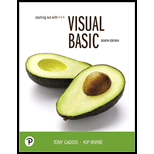
Concept explainers
Carpet Size
You have been asked to create an application for a carpet sales and installation business. The application should allow the user to enter the length and width of a room and calculate the room’s area in square feet. The formula for this calculation is
In this exercise, you will gain practice using Steps 1 through 6 of the
- 1. Clearly define what the application is to do.
- 2. Visualize the application running on the computer and design its user interface.
- 3. Determine the controls needed.
- 4. Define the values of each control’s relevant properties.
- 5. Determine the event handlers and other code needed for each control.
- 6. Create a flowchart or pseudocode version of the code.
Step 1: Describe the following
characteristics of this application:
Purpose
Input
Process
Output
Step 2: Draw a sketch of the application’s form and place all the controls that are needed.
Step 3: Make a list of the controls you included in your sketch. List the control type and the name of each control.
Step 4: List the value of the Text property for each control, as needed. (Remember, some controls do not have a Text property.)
Step 5: List each method needed. Give the name of each method and describe what each method does.
Step 6: For each method you listed in Step 5, draw a flowchart or write pseudocode.
Want to see the full answer?
Check out a sample textbook solution
Chapter 1 Solutions
Pearson eText for Starting Out With Visual Basic -- Instant Access (Pearson+)
Additional Engineering Textbook Solutions
Vector Mechanics For Engineers
BASIC BIOMECHANICS
Database Concepts (8th Edition)
Electric Circuits. (11th Edition)
Mechanics of Materials (10th Edition)
Thermodynamics: An Engineering Approach
- Given the schema below for the widgetshop, provide a schema diagram. Schema name Attributes Widget-schema Customer-schema (stocknum, manufacturer, description, weight, price, inventory) (custnum, name, address) Purchased-schema (custnum, stocknum, pdate) Requestedby-schema (stocknum, custnum) Newitem-schema (stocknum, manufacturer, description) Employee-schema (ssn, name, address, salary) You can remove the Newitem-schema (red).arrow_forwardTrue or False: Given the sets F and G with F being an element of G, is it always ture that P(F) is an element of P(G)? (P(F) and P(G) mean power sets). Why?arrow_forwardCan you please simplify (the domain is not empty) ∃xF (x) → ¬∃x(F (x) ∨ ¬G(x)). Foarrow_forward
- HistogramUse par(mfrow=c(2,2)) and output 4 plots with different argument settings.arrow_forward(use R language)Scatter plot(a). Run the R code example, and look at the help file for plot() function. Try different values for arguments:type, pch, lty, lwd, col(b). Use par(mfrow=c(3,2)) and output 6 plots with different argument settings.arrow_forward1. Draw flow charts for each of the following;a) A system that reads three numbers and prints the value of the largest number.b) A system reads an employee name (NAME), overtime hours worked (OVERTIME), hours absent(ABSENT) and determines the bonus payment (PAYMENT).arrow_forward
- Scenario You work for a small company that exports artisan chocolate. Although you measure your products in kilograms, you often get orders in both pounds and ounces. You have decided that rather than have to look up conversions all the time, you could use Python code to take inputs to make conversions between the different units of measurement. You will write three blocks of code. The first will convert kilograms to pounds and ounces. The second will convert pounds to kilograms and ounces. The third will convert ounces to kilograms and pounds. The conversions are as follows: 1 kilogram = 35.274 ounces 1 kilogram = 2.20462 pounds 1 pound = 0.453592 kilograms 1 pound = 16 ounces 1 ounce = 0.0283 kilograms 1 ounce = 0.0625 pounds For the purposes of this activity the template for a function has been provided. You have not yet covered functions in the course, but they are a way of reusing code. Like a Python script, a function can have zero or more parameters. In the code window you…arrow_forwardmake a screen capture showing the StegExpose resultsarrow_forwardWhich of the following is not one of the recommended criteria for strategic objectives? Multiple Choice a) realistic b) appropriate c) sustainable d) measurablearrow_forward
- Management innovations such as total quality, benchmarking, and business process reengineering always lead to sustainable competitive advantage because everyone else is doing them. a) True b) Falsearrow_forwardVision statements are more specific than strategic objectives. a) True b) Falsearrow_forwardThe three components of the __________ approach to corporate accounting include financial, environmental, and social performance measures. Multiple Choice a) stakeholder b) triple dimension c) triple bottom line d) triple efficiencyarrow_forward
 EBK JAVA PROGRAMMINGComputer ScienceISBN:9781305480537Author:FARRELLPublisher:CENGAGE LEARNING - CONSIGNMENTProgramming Logic & Design ComprehensiveComputer ScienceISBN:9781337669405Author:FARRELLPublisher:Cengage
EBK JAVA PROGRAMMINGComputer ScienceISBN:9781305480537Author:FARRELLPublisher:CENGAGE LEARNING - CONSIGNMENTProgramming Logic & Design ComprehensiveComputer ScienceISBN:9781337669405Author:FARRELLPublisher:Cengage EBK JAVA PROGRAMMINGComputer ScienceISBN:9781337671385Author:FARRELLPublisher:CENGAGE LEARNING - CONSIGNMENT
EBK JAVA PROGRAMMINGComputer ScienceISBN:9781337671385Author:FARRELLPublisher:CENGAGE LEARNING - CONSIGNMENT Programming with Microsoft Visual Basic 2017Computer ScienceISBN:9781337102124Author:Diane ZakPublisher:Cengage Learning
Programming with Microsoft Visual Basic 2017Computer ScienceISBN:9781337102124Author:Diane ZakPublisher:Cengage Learning C++ Programming: From Problem Analysis to Program...Computer ScienceISBN:9781337102087Author:D. S. MalikPublisher:Cengage Learning
C++ Programming: From Problem Analysis to Program...Computer ScienceISBN:9781337102087Author:D. S. MalikPublisher:Cengage Learning Microsoft Visual C#Computer ScienceISBN:9781337102100Author:Joyce, Farrell.Publisher:Cengage Learning,
Microsoft Visual C#Computer ScienceISBN:9781337102100Author:Joyce, Farrell.Publisher:Cengage Learning,





